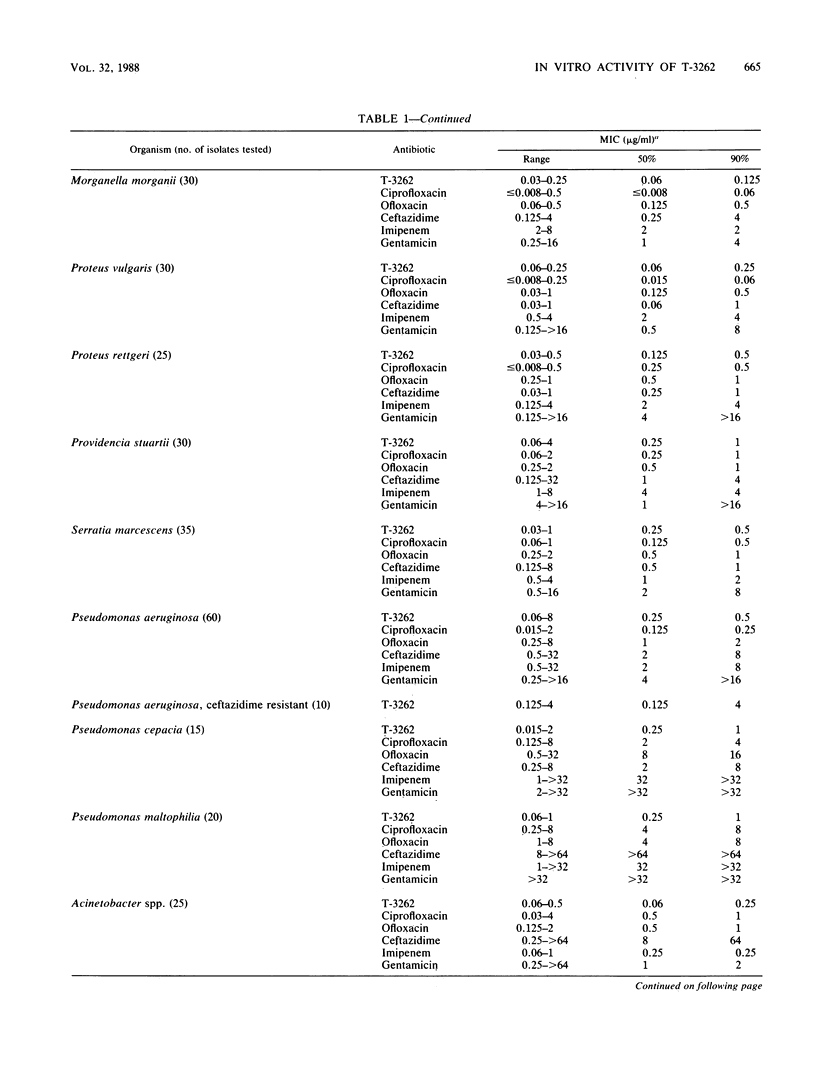Abstract
The in vitro activity of a new quinolone, T-3262 [A-60969; DL-7-(3-amino-1-pyrrolidinyl)-1-(2,4-difluorophenyl)-6-fluoro-1-, 4-dihydro-4-oxo-1,8-naphthyridine-3-carboxylic acid monohydrate], was compared with those of ciprofloxacin, ofloxacin, ceftazidime, imipenem, and gentamicin. T-3262 inhibited 90% of isolates of the family Enterobacteriaceae at a concentration of less than or equal to 0.25 micrograms/ml. It was two to four times more active than ofloxacin and similarly or slightly less active than ciprofloxacin. Ninety percent of isolates of Pseudomonas aeruginosa were inhibited at 0.5 micrograms/ml. It was 4- to 8-fold more active than ciprofloxacin and 8- to 16-fold more active than ofloxacin against Pseudomonas cepacia and Pseudomonas maltophilia, which were resistant to imipenem and gentamicin. Most Haemophilus influenzae, Neisseria gonorrhoeae, and Branhamella catarrhalis isolates were inhibited at concentrations of less than or equal to 0.008 micrograms/ml. The MIC for 90% of the Staphylococcus aureus isolates, including methicillin-resistant S. aureus, was 0.12 micrograms/ml; that for Staphylococcus epidermidis was 0.5 micrograms/ml, as was that for Enterococcus faecalis. It inhibited 90% of Bacteroides fragilis isolates at 2 micrograms/ml, considerably more active than ciprofloxacin and ofloxacin. The frequency of spontaneous point mutational resistance was less than 10(-10) for members of the family Enterobacteriaceae and Pseudomonas spp. Resistant strains could be selected by repeated subculture. Similar to other quinolones, its activity could be affected by culture conditions. T-3262 showed a postantibiotic suppressive effect on Escherichia coli, P. aeruginosa, and S. aureus.
Full text
PDF







Selected References
These references are in PubMed. This may not be the complete list of references from this article.
- Chin N. X., Brittain D. C., Neu H. C. In vitro activity of Ro 23-6240, a new fluorinated 4-quinolone. Antimicrob Agents Chemother. 1986 Apr;29(4):675–680. doi: 10.1128/aac.29.4.675. [DOI] [PMC free article] [PubMed] [Google Scholar]
- Chin N. X., Neu H. C. Post-antibiotic suppressive effect of ciprofloxacin against gram-positive and gram-negative bacteria. Am J Med. 1987 Apr 27;82(4A):58–62. [PubMed] [Google Scholar]
- Hirai K., Aoyama H., Irikura T., Iyobe S., Mitsuhashi S. Differences in susceptibility to quinolones of outer membrane mutants of Salmonella typhimurium and Escherichia coli. Antimicrob Agents Chemother. 1986 Mar;29(3):535–538. doi: 10.1128/aac.29.3.535. [DOI] [PMC free article] [PubMed] [Google Scholar]
- Hirschhorn L., Neu H. C. Factors influencing the in vitro activity of two new aryl-fluoroquinolone antimicrobial agents, difloxacin (A-56619) and A-56620. Antimicrob Agents Chemother. 1986 Jul;30(1):143–146. doi: 10.1128/aac.30.1.143. [DOI] [PMC free article] [PubMed] [Google Scholar]
- King A., Phillips I. The comparative in-vitro activity of eight newer quinolones and nalidixic acid. J Antimicrob Chemother. 1986 Nov;18 (Suppl 500):1–20. doi: 10.1093/jac/18.supplement_d.1. [DOI] [PubMed] [Google Scholar]
- Pearson R. D., Steigbigel R. T., Davis H. T., Chapman S. W. Method of reliable determination of minimal lethal antibiotic concentrations. Antimicrob Agents Chemother. 1980 Nov;18(5):699–708. doi: 10.1128/aac.18.5.699. [DOI] [PMC free article] [PubMed] [Google Scholar]
- Wolfson J. S., Hooper D. C. The fluoroquinolones: structures, mechanisms of action and resistance, and spectra of activity in vitro. Antimicrob Agents Chemother. 1985 Oct;28(4):581–586. doi: 10.1128/aac.28.4.581. [DOI] [PMC free article] [PubMed] [Google Scholar]


